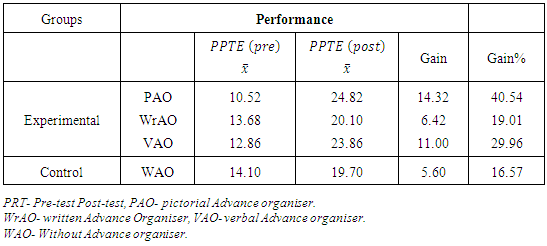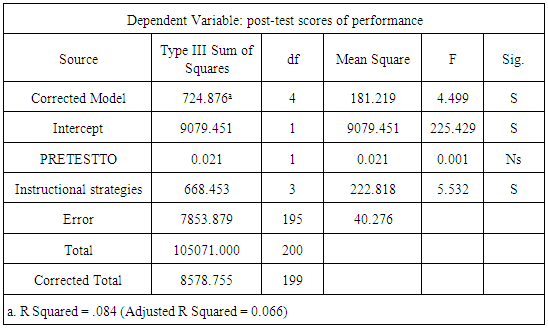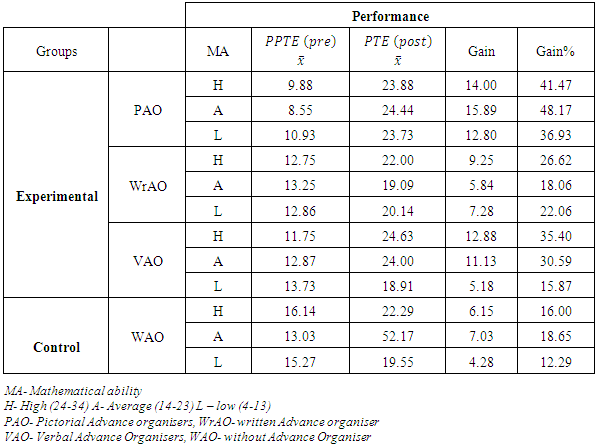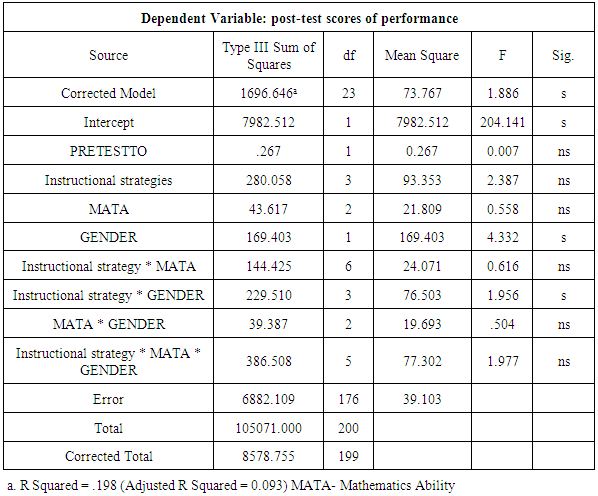-
Paper Information
- Paper Submission
-
Journal Information
- About This Journal
- Editorial Board
- Current Issue
- Archive
- Author Guidelines
- Contact Us
International Journal of Theoretical and Mathematical Physics
p-ISSN: 2167-6844 e-ISSN: 2167-6852
2017; 7(4): 61-67
doi:10.5923/j.ijtmp.20170704.01

Effects of Mathematics Knowledge on Physics Students Performance in Electromagnetism
Charles-Ogan Gladys Ibibo, Okey Innocent Francis
Curriculum Studies and Educational Technology, University of Port Harcourt, Nigeria
Correspondence to: Charles-Ogan Gladys Ibibo, Curriculum Studies and Educational Technology, University of Port Harcourt, Nigeria.
| Email: |  |
Copyright © 2017 Scientific & Academic Publishing. All Rights Reserved.
This work is licensed under the Creative Commons Attribution International License (CC BY).
http://creativecommons.org/licenses/by/4.0/

The paper investigated the effects of Mathematics Knowledge on Physics Students Performance in Electromagnetism. A sample of two hundred students (200) Physics students in senior secondary school 2 (SS2) was randomly selected. The design adopted in the study was a quasi-experimental Pretest-posttest control type with each group treated differently. The instruments physics performance test in electromagnetism in (PPTE) and Mathematics ability test in electromagnetism concepts (MATEC) with reliability coefficient 0.74 and 0.94 respectively, were used to obtain performance data of students. The data were analysed using mean, percentages and the analysis of covariance (ANCOVA). The results of the study showed that students of high mathematical ability have greater mean percentage gain of 41.17% while those of low mathematical ability have 36.93%. Mathematics ability, instructional strategies, and gender have a positive joint relationship with students’ performance in Physics (Electromagnetism) to a considerable extent 22.2% (r2 = 0.22). It was recommended that Physics students should be properly groomed in mathematics, problem-solving schedules should accompany conceptual treatment of numerical problems in the Physics Classroom. Use of innovative teaching strategies would improve interactivity, understanding, and application of concepts (numerical and non-numerical) in the learning of electromagnetism.
Keywords: Mathematics Knowledge, Physics Performance, Electromagnetism
Cite this paper: Charles-Ogan Gladys Ibibo, Okey Innocent Francis, Effects of Mathematics Knowledge on Physics Students Performance in Electromagnetism, International Journal of Theoretical and Mathematical Physics, Vol. 7 No. 4, 2017, pp. 61-67. doi: 10.5923/j.ijtmp.20170704.01.
Article Outline
1. Introduction
- Physics as a science that involves the study of the physical properties of matter and its interaction with the energy a study of systematised knowledge produced by careful observation, measurement, and experiment in a view to establishing basic physical laws as well as give a scientifically reliable explanation of physical phenomena. The study of Physics has made significant contributions through advances in new technologies that arise from the theoretical breakthrough. For example, advances in the understanding of electromagnetism led to the development of new products which have contributed to the transformation of modern society, such as television, computers, domestic appliances, and nuclear weapons (Wikipedia, 2010).Young and Freedman (2004) defined physics as an experimental science since its specialists observe the phenomena of nature and try to find patterns and principles that relate to those phenomena in the form of theories, physical laws or principles. Interestingly, the diversified concepts of the subject matter, have made its study relevant in many disciplines, such as engineering, medicine architecture, integrated science, chemistry, science education and mathematics.Mathematics knowledge has become inseparable and a sinequanon in the learning of qualitative aspects of arts and science. In scientific discourse, mathematics knowledge is the “language of science” (Redish, 2005). Mathematical calculations occur at every step-in physics. It is only mathematics that gives form and definiteness to the properties of matter and harnessing of nature is possible only through quantitative interpretations of ideas and imaginations. Mathematics pervades physics so much that its impact and influence can be felt in every part of it. (Sidhu, 2006).The effectiveness in student’s understanding and application of concepts in electromagnetism can be guaranteed through adequate possession of mathematics knowledge hence students understanding of the basic mathematical concepts which influence greatly how they cope with higher level; materials where the application of these basic mathematical concepts is required. Physics students have difficulties with mathematics understanding of the concepts in physics which demands adequate mathematical knowledge. Osborne, Simon and Collins (2003), Lord and Jones, (2006) maintained that: Physics students who lacked basic algebra performed poorly on mathematical problem-solving tasks in physics due to students’ lack knowledge of mathematical skills needed in problem-solving in physics or students do not know how to apply the mathematical skills they have to particularly solve the problems situation in physics. Although a wide conceptual difference exists between subjects (Physics and Mathematics) it is no longer history that mathematical knowledge is required to tackle numerical problems in physics, leaving much to be done in order to change students attitude towards mathematics and science.In Nigeria, Adeyemi (2007) who had studied mathematics as a language for involving secondary school children in science and technology, indicated that their performance in West African schools Certificates Examinations (SSCE) mathematics also correlated significantly with their performance in Physics in the same examination, which remained generally poor. In order to improve students’ understanding of mathematics, a lot of innovative strategies have been suggested and used, among mathematics majors - the use of interactive whiteboard for creative teaching and learning in literacy and mathematics: a case study (Wood and Ashfield, 2008), psycho- academic variables and mathematics achievement of 9th grade students in Nigeria (Joseph, 2012), play-way learning strategies involving use of games and the mathematics laboratory, among others. Brekke (2010) and Adegoke (2009) in assessing the Mathematics knowledge potential between two nations at the polar development of levels (developed or developing), in different research, lamented students continued difficulties in mathematics. While Adegoke observed that many students (Nigerian) appear to lack the reasoning ability involved in the study of physics, identified their problems as lack of logical-mathematics operations, Brekke lamented that a number of students (Americans) who come from elementary to high school is deficient in basic mathematics facts such as the result of dividing a number by zero. Obafemi and Ogunkunle (2014) stated that mathematics ability is significant in students’ performance in sound waves when taught using collaborative, Demonstration and Guided-Discovery learning method; hence there exist evidence of inter-relatedness between Physics and Mathematics. The conceptual understanding of electromagnetism in particular and the subject matter, in general, is difficult without adequate mathematics knowledge. Hence the need to improve mathematics knowledge on physics students’ performance in Electromagnetism.Purpose of the StudyThe purpose of this study was to investigate the effect of mathematics knowledge on physics students’ performance in Electromagnetism. Specifically, the objectives of the study were to:i. Evaluate student’s general performance in electromagnetism using the instructional strategies.ii. Investigate the intervening effects of instructional strategies on student’s performance in electromagnetism given their mathematical abilities.iii. Evaluate the intervening effect of instructional strategies on account of mathematical ability, and gender on students’ performance on electromagnetism.Research QuestionsThe following research questions were stated to guide this study:I. What is the students’ general performance in electromagnetism concepts?II. How does the mathematics ability of students affect their performance in electromagnetism concepts?III. How do mathematics abilities and gender jointly affect students’ performance on electromagnetism?HypothesesThe null hypotheses tested in this study include:Ho1: There is no significant difference in performance of students in electromagnetism when taught using the instructional strategies.Ho2: No significant difference exists between the performances of students when electromagnetism is taught using the instructional strategies, on their mathematics abilities.Ho3:There is no significant joint effect of instructional strategies, mathematics abilities, and gender on students’ performance in electromagnetism.
2. Methodology
- The study adopted a quasi-experimental, pre-test, post-test experimental and control design. The control group was not presented with advance organisers while the experimental groups had advance organisers differently as a pictorial (group 1), written (group II) and verbal (group III) taught using the concept map strategy. Purposive sampling techniques were used to select a sample of two hundred SS2 students (200) for this study. The instruments Physics Performance Test on Electromagnetism (PPTE) and the Mathematics Ability Test on Electromagnetism Concept (MATEC) were used to elicit student understanding and application of the concepts of electromagnetism and their mathematics abilities. MATEC consisted of 50 multiple choice questions on Mathematics based on mathematical concepts applicable in electromagnetism while PPTE consisted of 50 multiple choice questions in the concepts of electromagnetism based on the constructs of understanding and application. Difficulty indices of the instrument PPTE and MATEC are 33.3 and 50.0 respectively, and reliability coefficients calculated using Kuder-Richardson formula (K-R 21) as 0.74 and 0.99 respectively. The pre-test version of the PPTE and MATEC were administered to the students before instruction, at the end of 12 weeks of instruction, the post-test version of the PPTE and MATEC were administered. The scores of students were collated for data analysis. The statistical analysis tools for answering the stated research question were mean and percentages while Analysis of Covariance, (ANCOVA) was used for test of hypotheses.
3. Results
- Research Question I: What are the student's general performances in electromagnetism concepts?
|
|
|
|
|
4. Summary of Findings
- Ÿ Students of high mathematics ability have mean percentage gain of 41.17% while those of low mathematical ability have 36.93% in their performance in the concept of electromagnetism taught using pictorial advance organiser (PAO).Ÿ Mean percentage gain of the experimental group (30.57%) is greater than the mean percentage gain of the control group (15.65%) in their performance in Electromagnetism classified by high, average and low mathematical abilities.Ÿ Mathematics ability, instructional strategies, and gender have positive joint relationship with students’ performance in Physics (Electromagnetism) to a considerable extent of 22.2% (R2 = 0.222).Ÿ There is no significant difference between the performance of students in the concept of electromagnetism who were presented with advance organisers (PAO, WrAO, VAO) and those without the organisers when taught using concept map strategy.Ÿ At 0.05 significant level and degree of freedom df (3,197), there exist significant interaction effects of instructional strategies and mathematical ability on students’ performance in electromagnetism. Students of high mathematics ability contributed mostly to the high performance in electromagnetism concepts.
5. Discussion
- The performance of students was affected according to their mathematical abilities in the understanding and application of the concepts of electromagnetism. However, students taught with the pictorial advance organisers, of low mathematical abilities had a higher mean performance in the concepts (36.93%). This may have resulted from the interactive effect of the pictorial organizers and the realm of understanding is at a lower level in the cognitive domain of the taxonomy of educational objectives where much of mathematics skills may not be required and that an average mathematical ability is required for problem-solving in mathematical concepts in electromagnetism.Mathematics ability interacted favourably with the instructional strategies used for this study and accounted for a significant performance in the concepts of electromagnetism. Students of high mathematics ability contributed immensely to their high performance in electromagnetism taught using concept map strategy irrespective of their gender. These findings agreed with the view of Adeyemi (2007) that the performance of students in Mathematics and Physics correlate significantly, and the teaching of students using innovative strategies such as the use of concept map strategy and intervention of pictorial organisers contributed to a better in the corporation and retention of the concepts of electromagnetism.
6. Conclusions
- Adequate knowledge of mathematics is compulsorily required for the understanding and application of the concepts of electromagnetism hence effort has to be made in order to improve students’ acquisition of mathematics skills if they expect a positive learning outcome in Physics.
7. Recommendations
- Based on the findings of this research, the following recommendations are made.1. Students who offer Physics have a need for the proper inculcation of the basic mathematics principles, laws, and theories, especially as needed in the understanding and application of the Physics concepts.2. Students-centred interactive/innovative strategies such as the use of Advance Organizers and concept map strategy should be used in teaching electromagnetism concepts.3. Teachers of Physics should engage students with problem-solving schedules for familiarisation and retention of approaches to numerical problems in electromagnetism.
References
| [1] | Wikipedia (2010). Electromagnetism. Retrieved from http://enwikipedia.org/wikiscience. |
| [2] | Young, H.D & Freedman, R.A. (2004). University Physics. London: Addison Wesley. |
| [3] | Redish, E.F. (2005). Problem-solving and the use of mathematics in Physics courses. Retrieved from umdperg.pbworks.com/w/page/34255731/math-physics: -references. |
| [4] | Sidhu, K.S. (2006). The teaching of mathematics. India: Stirling publishers Private Ltd. |
| [5] | Osborne, J. Simon, S. & Collins, S (2003). Attitudes towards science: a review of the literature and its implications. International Journal of Science Education. 25, 1049-1079. |
| [6] | Lord, P. & Jones, M. (2006). Pupils’ experiences and perspectives of the National Curriculum and assessment. Final report for the research review Slough, UK: NFER. |
| [7] | Adeyemi, T.O (2007). Mathematics as a language for involving secondary school children in science and technology in Ondo State, Nigeria, Mathematics connection, (6) 11-21. |
| [8] | Wood, R & Ashfield, J. (2008). The use of the interactive whiteboard for creative teaching and learning in literacy and mathematics: a case study. British Journal of Educational Technology vol. 39(1), 84-96. |
| [9] | Joseph, E.U. (2012). Psycho-Academic Variables and Mathematics Achievement of 9th Grade students in Nigeria. British Journal of Education, Society & Behavioural Science 2(2), 174-183. |
| [10] | Brekke, S. (2010). Urgent mathematics crisis in our nation. Teachers.net retrieved from http://teachers.net/gazette/wordpress/category/stewart-bekke. |
| [11] | Adegoke, B.A. (2009). Determining factors in secondary school students choice of Physics. Journal of Science Teachers’ Association of Nigeria, 4 (1&2), 75-84. |
| [12] | Obafemi, D.T.A. & Ogunkunle, R.A. (2014). Mathematics abilities of secondary school Physics students and performance in sound waves. International Journal of Research and Development (IJRD) vol. 1 (1), 111-123. |
 Abstract
Abstract Reference
Reference Full-Text PDF
Full-Text PDF Full-text HTML
Full-text HTML




